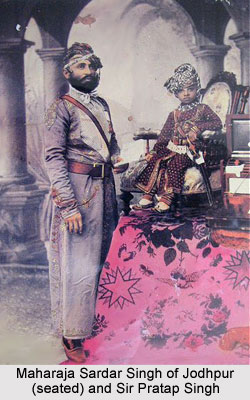 Princely States of India, alternatively known as Indian States or Native States, were nominally autonomous units under the British colonial rule in India. These states were generally not governed by the British administration directly, but were controlled by an Indian Prince under a type of indirect British rule, like paramountcy or suzerainty. According to official records, there were 565 princely states at the time of the Indian independence during 1947. Most of these states were under contract with the Viceroy and in agreement of providing public services and tax collections. Only 21 states, amongst all the Princely States of India had authentic state governments and only Kashmir, Hyderabad and Mysore were three large states. These were incorporated into the 2 new independent nations from 1947- 1949. The process faced problems, mostly in Kashmir and somewhat in Hyderabad. All of the Indian Princes were pensioned off in due course.
Princely States of India, alternatively known as Indian States or Native States, were nominally autonomous units under the British colonial rule in India. These states were generally not governed by the British administration directly, but were controlled by an Indian Prince under a type of indirect British rule, like paramountcy or suzerainty. According to official records, there were 565 princely states at the time of the Indian independence during 1947. Most of these states were under contract with the Viceroy and in agreement of providing public services and tax collections. Only 21 states, amongst all the Princely States of India had authentic state governments and only Kashmir, Hyderabad and Mysore were three large states. These were incorporated into the 2 new independent nations from 1947- 1949. The process faced problems, mostly in Kashmir and somewhat in Hyderabad. All of the Indian Princes were pensioned off in due course.
Under the British imperial rule, India primarily consisted of 2 kinds of territories-
* British India
* Princely States or Native States
In the Interpretation Act 1889, the British Parliament provided the following descriptions-
* The term British India denotes all the all regions and territories within the dominion of Her Majesty, which are governed by Her Majesty through the Governor-General of India or through any governor or other officer subordinate to the Governor-General of India
* The term India represents British India along with any territories of any native prince or chief under the suzerainty of Her Majesty exercised through the Governor-General of India or any governor or other officer subordinate to the Governor-General of India.
The suzerainty of the British Crown over 175 Indian Princely States was exercised by the central government of British India under the Viceroy. The rest of the 400 states were influenced by Agents accountable to the provincial governments of British India under a Governor, Lieutenant Governor or Chief Commissioner. The law of British India was decided upon by the legislation enacted by the British Parliament. The courts of the Princely States sustained under the authority of the respective princes of the states. The Indian Princes had several titles such as Badshah, Chattrapati, Maharaja, Thakur, Nawab, Wali, Nizam and others. Even though theses titles conveyed traditional and cultural prestige, the British administration identified all of the rulers as Prince. This was mainly done in order to evade the inference that the native rulers could become Kings with status that could be equivalent to the British monarch.
The British Empire completely controlled the external affairs of the princely states of India. As the princely states were not under direct control of the British, the Indian Princes maintained control over their internal affairs. But it was subject to a level of British influence, which was considerably significant in many states.






































